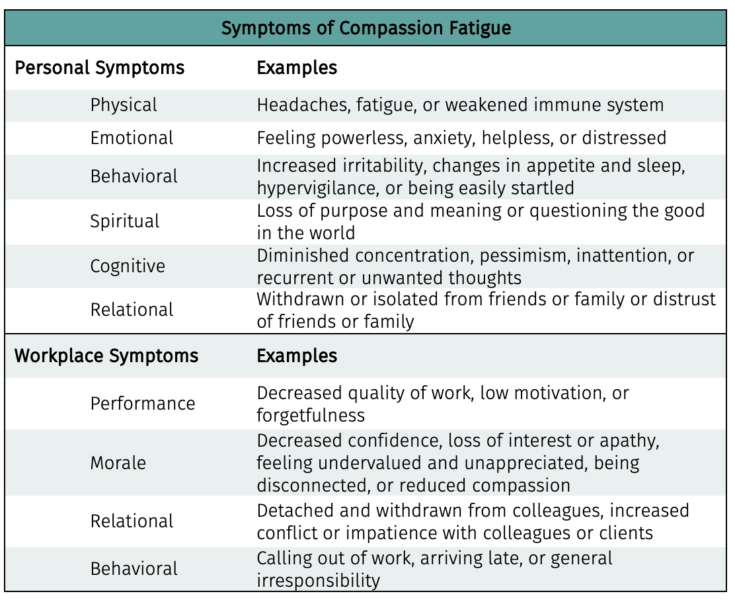Compassion Fatigue: Surviving in the post Covid culture.
Compassion fatigue is a kind of stress that results from helping or wanting to help those who are traumatized or under significant emotional duress. Frequently though mistakenly, compassion fatigue is interchangeably used with burnout. It is crucial that before we learn more about compassion fatigue, we make the difference between burnout and compassion fatigue more explicit, as below:
| Compassion Fatigue | Burnout |
| Onset may be short / sudden | Onset over a period of time, cumulative |
| Highly treatable | Less treatable |
| May not be identified easily | Relatively identifiable |
| Requires skilled ways to address | Frequently, change in job / vacation helps |
| Arises with the suffering of the others, secondary trauma | Arises with problems / challenges being faced by the self |
| Burnout is a component of compassion fatigue | – |
Compassion fatigue is a precursor for several other stressors. It is a phenomenon that hits the hardest upon those in the helping profession, bringing out the hard fact that there is a cost to caring too. The term compassion fatigue was coined by Charles Figley (also known as the father of compassion fatigue), in the 1980s, where it was primarily studied amongst health-care professionals such as nurses and doctors. However, as time elapsed, compassion fatigue started being studied amongst a myriad of professionals such as clergy, teachers, social workers, para-medics, advocate volunteers, caregivers and police personnel. In today’s time, it is recognised that the police personnel are the least studied group of professionals when it comes to burnout as well as compassion fatigue (whereas the nursing profession is the most researched group).

Compassion fatigue is also referred to as psychological erosion, secondary stress reaction or second-hand shock and is not identified easily as a result of the rewarding nature of work.. The symptoms of compassion fatigue often overlap with that of post-traumatic stress disorder (PTSD) such as hypervigilance, fatigue, depression or low mood, flashback of traumatic or disturbing experiences and depersonalisation. Among others, symptoms of compassion fatigue also include irritability, headaches, changes in or disturbed sleep and appetite, lack of belief in self, lack of belief in being able to do well, lack of compassion towards others (clients, patients, students, pupils) and chronic physical and emotional exhaustion. An understanding of the concept can help individuals be alert about certain signs and symptoms that can be identified well in-time to prevent fatigue and extend the efficacy of work.

There are certain risk factors that may increase a person’s vulnerability to compassion fatigue. Personal risk factors for compassion fatigue can include having a history of trauma or a pre-existing psychological disorder, isolation and a lack of social support. Professional risk factors can include a lack of professional support or supervision, inadequate training and a high number of clients with severe traumatic experiences. Some other general risk factors that predispose individuals to compassion fatigue are:
- professions that expose you to high-risk work
- extreme work environments
- working with people with experiences of trauma, suicidal ideation, mental illness, exposure to abuse
- work overload, stress with co-worker
- excessive empathy
- ongoing motivation to help those in need
- life demands
- lack of socio-emotional support
Researches since the 1970s have delineated that empathy has been reducing among the youth since the 1970s, especially more since 2000; the culprit being social media. Social media, though built with an aim to connect people has actually pulled people apart ever since its advent and is also being understood as one of the prime reasons to have contributed to reduced empathy among individuals. Thus, in a time where empathy is progressively dwindling and prone-ness to compassion fatigue is high, there is a need for greater awareness and action-based intervention to address the same. Apart from the various strategies that can be deployed to keep compassion fatigue at bay, here are some ways (some difficult ones too, maybe) that can be adopted to churn greater energy:
- Get educated and be observant of the most common signs & symptoms of compassion fatigue
- You can rank your compassion fatigue on a scale of 0-10 as self-checks for management and prevention
- Overworking is often at the heart of compassion fatigue and its first cousin: vicarious trauma
- Challenge is to remain compassionate, empathetic, and supportive of others without becoming overly involved and taking on another’s pain
- Simply taking short breaks throughout the day to close your eyes, focus on your breath, or put your hands on your heart and send yourself some compassion
- Making time for leisure activities and personal hobbies outside of work can help lower stress levels and improve overall life satisfaction
- Connecting with friends who are not aware of the ins and outs of your work situation can provide much needed emotional and professional relief
- Accepting that pain and suffering is an inevitable part of life and finding meaning in this suffering is one of the ways to manage compassion fatigue
- Being fully present and mindfully doing the smallest and simplest things can help; for example, sipping your tea mindfully, taking every minute of the break or eating every bite slowly to enjoy your meal
- Finding a gateway is important. Gateway can be an outlet or a channelising mechanism to utilise the energy in a positive / constructive manner
- Knowing one’s limits is important so one can draw boundaries and limits about what and how much one can give without having to experience burnout
- Humour can be a great strategy to lighten the environment and defer the burnout / fatigue process
Practicing self-awareness and self-monitoring to recognize changes in behavior, work, and life outside of work is the first step to preventing compassion fatigue. Self-care to prevent compassion fatigue needs to be holistic- physical, emotional, social and professional. At the heart of self care is compassion. As rightly put, “If you want others to be happy, practice compassion. If you want to be happy, practice compassion.”
Also, sharing with all readers an extremely helpful resource to self-reflect and check for compassion fatigue- Reflective Caritas Inventory (Rosa, 2014).

________________________________________________________________________________
About the Author:

Pragya Lodha is a Clinical Psychologist. Apart from her private practice, she works with 8 other national and international organisations in different capacities. She has 100+ national and international publications and is a teaching faculty for postgraduate students in Psychology.




Leave a Reply